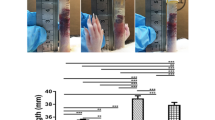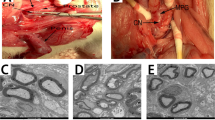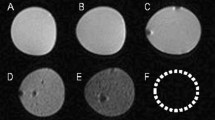Abstract
Adenovirus or naked plasmid DNA (pDNA) has been used to deliver the therapeutic gene into corpus cavernosum. However, the potential risks of viral vector and inefficiency of naked pDNA have limited their clinical application. In this study, water-soluble lipopolymer (WSLP) was evaluated as a gene carrier to corpus cavernosum. The WSLP/pDNA complex was transfected to smooth muscle cells in vitro. WSLP had high transfection efficiency, which was comparable to poly(ethylenimine) (PEI). In addition, WSLP had much less cytotoxicity than PEI, suggesting that WSLP is a safer carrier than PEI. To evaluate the transfection efficiency to corpus cavernosum, the WSLP/pDNA complex was injected into the rat corpus cavernosum. As a result, the WSLP/pDNA complex showed higher transfection efficiency than naked pDNA. In addition, the gene expression was dependent upon the dose of the complex. The results suggest that WSLP may be useful for gene therapy of erectile dysfunction.
This is a preview of subscription content, access via your institution
Access options
Subscribe to this journal
Receive 8 print issues and online access
$259.00 per year
only $32.38 per issue
Buy this article
- Purchase on Springer Link
- Instant access to full article PDF
Prices may be subject to local taxes which are calculated during checkout







Similar content being viewed by others
References
Edelstein ML, Abedi MR, Wixon J, Edelstein RM . Gene therapy clinical trials worldwide 1989–2004—an overview. J Gene Med 2004; 6: 597–602.
Wilson JM . Adenoviruses as gene-delivery vehicles. N Engl J Med 1996; 334: 1185–1187.
Kabanov AV, Kabanov VA . DNA complexes with polycations for the delivery of genetic material into cells. Bioconjug Chem 1995; 6: 7–20.
Temin HM . Safety considerations in somatic gene therapy of human disease with retrovirus vectors. Hum Gene Ther 1990; 1: 111–123.
Miller DG, Adam MA, Miller AD . Gene transfer by retrovirus vectors occurs only in cells that are actively replicating at the time of infection. Mol Cell Biol 1990; 10: 4239–4242.
Cotton M, Wagner E . Non-viral approaches to gene therapy. Curr Opin Biotechnol 1993; 4: 705–710.
Lee M, Kim SW . Polymeric gene carriers. Pharm News 2002; 9: 407–415.
Champion HC et al. Gene transfer of endothelial nitric oxide synthase to the penis augments erectile responses in the aged rat. Proc Natl Acad Sci USA 1999; 96: 11648–11652.
Bivalacqua TJ et al. Adenoviral gene transfer of endothelial nitric oxide synthase (eNOS) to the penis improves age-related erectile dysfunction in the rat. Int J Impot Res 2000; 12(Suppl 3): S8–S17.
Tirney S et al. Nitric oxide synthase gene therapy for erectile dysfunction: comparison of plasmid, adenovirus, and adenovirus-transduced myoblast vectors. Mol Urol 2001; 5: 37–43.
Magee TR et al. Gene therapy of erectile dysfunction in the rat with penile neuronal nitric oxide synthase. Biol Reprod 2002; 67: 1033–1041.
Bivalacqua TJ et al. Gene transfer of endothelial nitric oxide synthase partially restores nitric oxide synthesis and erectile function in streptozotocin diabetic rats. J Urol 2003; 169: 1911–1917.
Chancellor MB et al. Nitric oxide synthase gene transfer for erectile dysfunction in a rat model. Br J Urol Int 2003; 91: 691–696.
Bivalacqua TJ et al. Effect of combination endothelial nitric oxide synthase gene therapy and sildenafil on erectile function in diabetic rats. Int J Impot Res 2004; 16: 21–29.
Bivalacqua TJ et al. Gene transfer of prepro-calcitonin gene-related peptide restores erectile function in the aged rat. Biol Reprod 2001; 65: 1371–1377.
Lee MC et al. The effect of vascular endothelial growth factor on a rat model of traumatic arteriogenic erectile dysfunction. J Urol 2002; 167: 761–767.
Gholami SS et al. The effect of vascular endothelial growth factor and adeno-associated virus mediated brain derived neurotrophic factor on neurogenic and vasculogenic erectile dysfunction induced by hyperlipidemia. J Urol 2003; 169: 1577–1581.
Rogers RS et al. Intracavernosal vascular endothelial growth factor (VEGF) injection and adeno-associated virus-mediated VEGF gene therapy prevent and reverse venogenic erectile dysfunction in rats. Int J Impot Res 2003; 15: 26–37.
Christ GJ et al. Intracorporal injection of hSlo cDNA in rats produces physiologically relevant alterations in penile function. Am J Physiol 1998; 275: H600–H608.
Melman A et al. The successful long-term treatment of age related erectile dysfunction with hSlo cDNA in rats in vivo. J Urol 2003; 170: 285–290.
Abdallah B et al. A powerful nonviral vector for in vivo gene transfer into the adult mammalian brain: polyethylenimine. Hum Gene Ther 1996; 7: 1947–1954.
Godbey WT, Wu KK, Mikos AG . Size matters: molecular weight affects the efficiency of poly(ethylenimine) as a gene delivery vehicle. J Biomed Mater Res 1999; 45: 268–275.
Benns JM et al. Folate-PEG-folate-graft-polyethylenimine-based gene delivery. J Drug Target 2001; 9: 123–139.
Han S, Mahato RI, Kim SW . Water-soluble lipopolymer for gene delivery. Bioconjug Chem 2001; 12: 337–345.
Lee M et al. Water-soluble lipopolymer as an efficient carrier for gene delivery to myocardium. Gene Therapy 2003; 10: 585–593.
Lee M, Han S, Ko KS, Kim SW . Cell type specific and glucose responsive expression of interleukin-4 by using insulin promoter and water soluble lipopolymer. J Control Release 2001; 75: 421–429.
Mahato RI et al. Intratumoral delivery of p2CMVmIL-12 using water-soluble lipopolymers. Mol Ther 2001; 4: 130–138.
Moreland RB et al. PGE1 suppresses the induction of collagen synthesis by transforming growth factor-β1 in human corpus cavernosum smooth muscle. J Urol 1995; 153: 826–834.
Lemkine GF et al. Optimisation of polyethylenimine-based gene delivery to mouse brain. J Drug Target 1999; 7: 305–312.
Turunen MP et al. Efficient adventitial gene delivery to rabbit carotid artery with cationic polymer–plasmid complexes. Gene Therapy 1999; 6: 6–11.
Wightman L, Patzelt E, Wagner E, Kircheis R . Development of transferrin-polycation/DNA based vectors for gene delivery to melanoma cells. J Drug Target 1999; 7: 293–303.
Nguyen HK et al. Evaluation of polyether-polyethyleneimine graft copolymers as gene transfer agents. Gene Therapy 2000; 7: 126–138.
Lee M et al. Water-soluble and low molecular weight chitosan-based plasmid DNA delivery. Pharm Res 2001; 18: 427–431.
Acknowledgements
This study was supported by Grant No. R01-2002-000-00009-0 (2002) from the Basic Research Program of the Korea Science and Engineering Foundation. We thank Expression Genetics Inc. for providing WSLP.
Author information
Authors and Affiliations
Corresponding author
Rights and permissions
About this article
Cite this article
Lee, M., Ryu, JK., Oh, SM. et al. Water-soluble lipopolymer as a gene carrier to corpus cavernosum. Int J Impot Res 17, 326–334 (2005). https://doi.org/10.1038/sj.ijir.3901314
Received:
Revised:
Accepted:
Published:
Issue Date:
DOI: https://doi.org/10.1038/sj.ijir.3901314
Keywords
This article is cited by
-
Embryonic stem cell-derived extracellular vesicle-mimetic nanovesicles rescue erectile function by enhancing penile neurovascular regeneration in the streptozotocin-induced diabetic mouse
Scientific Reports (2019)
-
RETRACTED ARTICLE: Pluronic-based nano-self-assemblies of bacitracin A with a new mechanism of action for an efficient in vivo therapeutic effect against bacterial peritonitis
Journal of Nanobiotechnology (2018)
-
Anti-Inflammatory Therapeutic Effect of Adiponectin Gene Delivery Using a Polymeric Carrier in an Acute Lung Injury Model
Pharmaceutical Research (2017)
-
Polymeric gene delivery of ischemia-inducible VEGF significantly attenuates infarct size and apoptosis following myocardial infarct
Gene Therapy (2009)
-
Vascular endothelial growth factor (VEGF) gene therapy using a nonviral gene delivery system improves erectile function in a diabetic rat model
International Journal of Impotence Research (2008)



